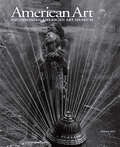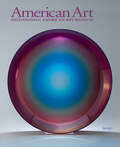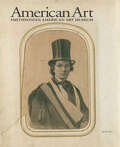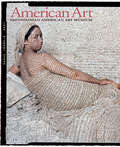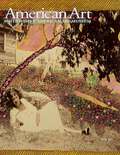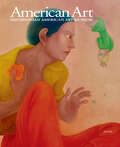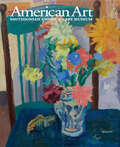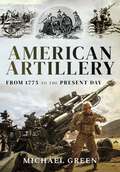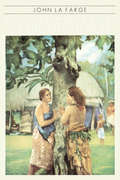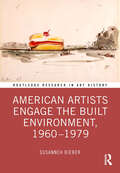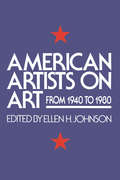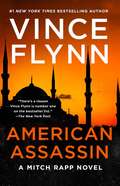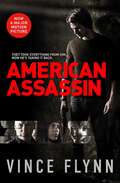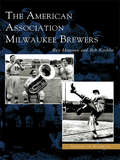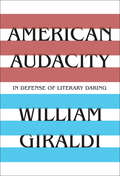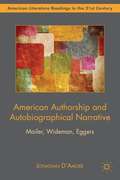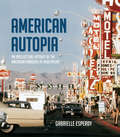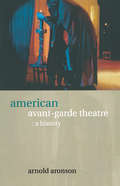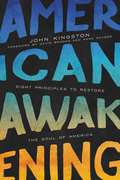- Table View
- List View
American Art to 1900: A Documentary History
by John Davis Sarah BurnsFrom the simple assertion that "words matter" in the study of visual art, this comprehensive but eminently readable volume gathers an extraordinary selection of words—painters and sculptors writing in their diaries, critics responding to a sensational exhibition, groups of artists issuing stylistic manifestos, and poets reflecting on particular works of art. Along with a broad array of canonical texts, Sarah Burns and John Davis have assembled an astonishing variety of unknown, little known, or undervalued documents to convey the story of American art through the many voices of its contemporary practitioners, consumers, and commentators. American Art to 1900 highlights such critically important themes as women artists, African American representation and expression, regional and itinerant artists, Native Americans and the frontier, popular culture and vernacular imagery, institutional history, and more. With its hundreds of explanatory headnotes providing essential context and guidance to readers, this book reveals the documentary riches of American art and its many intersecting histories in unprecedented breadth, depth, and detail.
American Art, volume 36 number 2 (Summer 2022)
by American ArtThis is volume 36 issue 2 of American Art. American Art publishes innovative peer-reviewed scholarship on the history of art and related visual culture. The journal critically engages with the material and conceptual conditions of art and provides a forum for the expanding field of American art history. It welcomes scholarship on the role played by art in the ongoing transnational and transcultural formation of America as a contested geography, identity, and idea. Committed to rigorous inquiry, the journal presents a range of approaches to the production and consumption of art.
American Art, volume 36 number 3 (Fall 2022)
by American ArtThis is volume 36 issue 3 of American Art. American Art publishes innovative peer-reviewed scholarship on the history of art and related visual culture. The journal critically engages with the material and conceptual conditions of art and provides a forum for the expanding field of American art history. It welcomes scholarship on the role played by art in the ongoing transnational and transcultural formation of America as a contested geography, identity, and idea. Committed to rigorous inquiry, the journal presents a range of approaches to the production and consumption of art.
American Art, volume 37 number 1 (Spring 2023)
by American ArtThis is volume 37 issue 1 of American Art. American Art publishes innovative peer-reviewed scholarship on the history of art and related visual culture. The journal critically engages with the material and conceptual conditions of art and provides a forum for the expanding field of American art history. It welcomes scholarship on the role played by art in the ongoing transnational and transcultural formation of America as a contested geography, identity, and idea. Committed to rigorous inquiry, the journal presents a range of approaches to the production and consumption of art.
American Art, volume 37 number 2 (Summer 2023)
by American ArtThis is volume 37 issue 2 of American Art. American Art publishes innovative peer-reviewed scholarship on the history of art and related visual culture. The journal critically engages with the material and conceptual conditions of art and provides a forum for the expanding field of American art history. It welcomes scholarship on the role played by art in the ongoing transnational and transcultural formation of America as a contested geography, identity, and idea. Committed to rigorous inquiry, the journal presents a range of approaches to the production and consumption of art.
American Art, volume 37 number 3 (Fall 2023)
by American ArtThis is volume 37 issue 3 of American Art. American Art publishes innovative peer-reviewed scholarship on the history of art and related visual culture. The journal critically engages with the material and conceptual conditions of art and provides a forum for the expanding field of American art history. It welcomes scholarship on the role played by art in the ongoing transnational and transcultural formation of America as a contested geography, identity, and idea. Committed to rigorous inquiry, the journal presents a range of approaches to the production and consumption of art.
American Art, volume 38 number 1 (Spring 2024)
by American ArtThis is volume 38 issue 1 of American Art. American Art publishes innovative peer-reviewed scholarship on the history of art and related visual culture. The journal critically engages with the material and conceptual conditions of art and provides a forum for the expanding field of American art history. It welcomes scholarship on the role played by art in the ongoing transnational and transcultural formation of America as a contested geography, identity, and idea. Committed to rigorous inquiry, the journal presents a range of approaches to the production and consumption of art.
American Art, volume 38 number 2 (Summer 2024)
by American ArtThis is volume 38 issue 2 of American Art. American Art publishes innovative peer-reviewed scholarship on the history of art and related visual culture. The journal critically engages with the material and conceptual conditions of art and provides a forum for the expanding field of American art history. It welcomes scholarship on the role played by art in the ongoing transnational and transcultural formation of America as a contested geography, identity, and idea. Committed to rigorous inquiry, the journal presents a range of approaches to the production and consumption of art.
American Art, volume 38 number 3 (Fall 2024)
by American ArtThis is volume 38 issue 3 of American Art. American Art publishes innovative peer-reviewed scholarship on the history of art and related visual culture. The journal critically engages with the material and conceptual conditions of art and provides a forum for the expanding field of American art history. It welcomes scholarship on the role played by art in the ongoing transnational and transcultural formation of America as a contested geography, identity, and idea. Committed to rigorous inquiry, the journal presents a range of approaches to the production and consumption of art.
American Art, volume 39 number 1 (Spring 2025)
by American ArtThis is volume 39 issue 1 of American Art. American Art publishes innovative peer-reviewed scholarship on the history of art and related visual culture. The journal critically engages with the material and conceptual conditions of art and provides a forum for the expanding field of American art history. It welcomes scholarship on the role played by art in the ongoing transnational and transcultural formation of America as a contested geography, identity, and idea. Committed to rigorous inquiry, the journal presents a range of approaches to the production and consumption of art.
American Artillery: From 1775 to the Present Day
by Michael GreenAn extensively illustrated history covering the artillery weaponry of the United States military from the eighteenth to the twenty-first century.The first regiment of artillery in the American Continental Army was formed in 1775. During the American Civil War almost a century later, artillery evolved from the employment of individual batteries to massed fire of grouped batteries.In 1907, the US Army Artillery Corps was reorganized into the Field Artillery and the Coast Artillery Corps. During the First World War, a lack of American-made weapons saw the adoption of foreign artillery pieces. The Second World War demanded the introduction of many new field artillery pieces by the US Army. General Patton later commented, “I don’t have to tell you who won the war, you know our artillery did.”American artillery firepower also took a heavy toll of the enemy during the Korean and Vietnam Wars. During the Cold War American artillery continued to develop, as the military embraced new weapons systems including tactical nuclear missiles, which thankfully never had to be used. Conventional artillery continued to prove highly effective in the country’s twenty-first century wars. This superbly illustrated and authoritative work covers the full range of artillery weaponry that has been in service with US armed forces.“Full of technical details on cannon, rocket and missile launchers, munitions, and fire-direction equipment. There is also considerable information on how new ordnance was developed and adopted into service over time.” —Military Heritage Magazine
American Artist In The South Sea
by John La FargeThe American artists John La Farge preceded Gauguin to the Pacific, and in their time his reputation as the modern Pacific painter far overshadowed that of the Frenchman. This remarkable work is the record of a year-long artistic odyssey through the South Seas, during which La Farge braved the volcanoes of Hawaii, visited Robert Louis Stevenson in Samoa, was adopted by a noble Tahitian family and journeyed through the wild hills of Fiji, painting and sketching lyrical studies of island life. Lavishly illustrated with his work, this account of the Polynesian adventures that La Farge shared with his friend the historian Henry Adams is an important contribution to the literary and artistic heritage of the Pacific and a revealing insight into the life of a complex and fascinating man.
American Artists Engage the Built Environment, 1960-1979 (Routledge Research in Art History)
by Susanneh BieberThis volume reframes the development of US-American avant-garde art of the long 1960s—from minimal and pop art to land art, conceptual art, site-specific practices, and feminist art—in the context of contemporary architectural discourses. Susanneh Bieber analyzes the work of seven major artists, Donald Judd, Robert Grosvenor, Claes Oldenburg, Robert Smithson, Lawrence Weiner, Gordon Matta-Clark, and Mary Miss, who were closely associated with the formal-aesthetic innovations of the period. While these individual artists came to represent diverse movements, Bieber argues that all of them were attracted to the field of architecture—the work of architects, engineers, preservationists, landscape designers, and urban planners—because they believed these practices more directly shaped the social and material spaces of everyday life. This book’s contribution to the field of art history is thus twofold. First, it shows that the avant-garde of the long 1960s did not simply develop according to an internal logic of art but also as part of broader sociocultural discourses about buildings and cities. Second, it exemplifies a methodological synthesis between social art history and poststructural formalism that is foundational to understanding the role of art in the construction of a more just and egalitarian society. The book will be of interest to scholars working in art history, architecture, urbanism, and environmental humanism.
American Artists On Art: From 1940 To 1980
by Sherron SparksFrom the Preface: The fact that so much of modern art has devoted itself to the exploration and assertion of its own identity is reflected in, but does not explain, the increasing amount of writing and talking on the part of contemporary artists. Rather, the whole history of the changing role of art and artists in a democratic, industrial, and technological society stands behind the spate of artists' words and the public's hunger for them--even some of the general public out there beyond art's little circle. Statements by artists appeal somewhat the way drawings do: they bring us, or at least they hold the promise of bringing us, closer to the artist's thoughts and feelings and to an understanding of his or her modus operandi; they hold the keys to a mysterious realm. And sometimes they offer us the sheer pleasure of good reading. Such is the primary raison d'etre of this book.Its other motivation is educational, and stems from the frustrating lack, in teaching contemporary art, of any single compilation of statements by American artists from 1940 to the present.... This anthology differs in several respects from those others that do include documents of American art since 1940.... The selection I have made is devoted exclusively to statements of artists; it is limited to the last four decades; it presents in a single volume a representative and fairly comprehensive coverage of major developments in American art beginning with Abstract Expressionism; and, whenever possible, it cities the first, or among the very earliest, documents signalizing a shift in the definition, intent, or direction of art."
American Assassin: A Thriller (A Mitch Rapp Novel #1)
by Vince FlynnIn #1 New York Times bestselling author Vince Flynn&’s explosive and &“captivating&” (Glenn Beck) thriller, witness the young Mitch Rapp as he takes on his first assignment.Mitch Rapp was a gifted college athlete without a care in the world…and then tragedy struck. Terrorists attacked innocent American citizens, and Rapp&’s girlfriend was among the murdered. Two hundred and seventy souls perished on that cold December night, and thousands of family and friends were left searching for comfort. Mitch Rapp was one of them, but he was not interested in comfort. Now he wants retribution. Two decades of cutthroat partisan politics have left the CIA and the country in an increasingly vulnerable position. Cold War veteran CIA Operations Director Thomas Stansfield knows he must prepare his people for the next war. America must confront Islamic terrorism with full force. Stansfield directs his protégée, Irene Kennedy, and his old Cold War colleague, Stan Hurley, to form a new group of clandestine operatives who will work outside the normal chain of command—men who do not exist. What type of man is willing to kill for his country without putting on a uniform? Six months of intense training have prepared him to take the war to the enemy&’s doorstep, and he does so with brutal efficiency. Rapp starts in Istanbul, where he assassinates the Turkish arms dealer who sold the explosives used in the terrorist attack. Rapp then moves on to Hamburg with his team and across Europe, leaving a trail of bodies. All roads lead to Beirut, though, and what Rapp doesn't know is that the enemy is aware of his existence and has prepared a trap. The hunter is about to become the hunted, and Rapp will need every ounce of skill and cunning if he is to survive the war-ravaged city and its various terrorist factions. This is &“a bold and brawny tale that never wavers or lets up. The voice of today&’s postmodern thriller generation, Flynn has never been better&” (The Providence Journal) in this unforgettable novel of a young man primed to become an American assassin.
American Assassin: A Thriller (The Mitch Rapp Series #1)
by Vince FlynnA Simon & Schuster eBook. Simon & Schuster has a great book for every reader.
American Assassin: A race against time to bring down terrorists. A high-octane thriller that will keep you guessing. (The Mitch Rapp Series #1)
by Vince FlynnTensions in the Middle East are simmering when Central Intelligence Angency Director Irene Kennedy pays a visit to Syracuse University, where she hopes to recruit none other than Mitch Rapp, a student who has quickly climbed up the academic and athletic ranks. At first glance, he appears like any other smart, good-looking American college kid. Under the surface, however, a tempest rages. Tragedy entered Mitch's life a year before when 35 of his classmates, including his girlfriend, perished on Pan Am flight 103. Since then, Mitch has grieved their senseless deaths and has felt helpless in his desire for revenge. When Kennedy arrives on campus, his career path is suddenly laid out for him. Nine months later, after gruelling training, Mitch finds himself in Istanbul on his first assignment, which is to assassinate the Turkish arms dealer who sold the explosives used in the Pan Am attack. Mitch hits his target but quickly sees, for the first time, what revenge means to the enemy. When Mitch's mentor and a fellow recruit are kidnapped and tortured by a dangerous group of Islamic jihadists, he must stop at nothing to save them.
American Association Milwaukee Brewers, The (Images of Baseball)
by Bob Koehler Rex HamannMany people know of Milwaukee's famous beer brewers, such as Schlitz, Pabst, and Miller, but these pages contain the story of the original baseball Brewers. The Milwaukee Brewers of the American Association spent 51 seasons (1902-1952) on the city's near north side. To have had the opportunity to stretch out in the sun-soaked stands of Borchert Field during that era was to witness minor league baseball at its best. The Brewers were the second-winningest franchise in the league's history, and names like Tom "Sugar Boy" Dougherty and Nick "Tomato Face" Cullop were once household words throughout the city. This book stands as a tribute to the colorful history of this team and to all the former players, coaches, and managers who ever wore the woolens for Milwaukee.
American Audacity: In Defense Of Literary Daring
by William GiraldiOne of the most gifted literary essayists of his generation defends stylistic boldness and intellectual daring in American letters. Over the last decade William Giraldi has established himself as a charismatic and uncompromising literary essayist, “a literature-besotted Midas of prose” (Cynthia Ozick). Now, American Audacity gathers a selection of his most powerful considerations of American writers and themes—a “gorgeous fury of language and sensibility” (Walter Kirn)—including an introductory call to arms for twenty-first-century American literature, and a new appreciation of James Baldwin’s genius for nonfiction. With potent insights into the storied tradition of American letters, and written with a “commitment to the dynamism and dimensions of language,” American Audacity considers giants from the past (Herman Melville, Edgar Allan Poe, Harper Lee, Denis Johnson), some of our most well-known living critics and novelists (Harold Bloom, Stanley Fish, Katie Roiphe, Cormac McCarthy, Allan Gurganus, Elizabeth Spencer), as well as those cultural-literary themes that have concerned Giraldi as an American novelist (bestsellers, the “problem” of Catholic fiction, the art of hate mail, and his viral essay on bibliophilia). Demanding that literature be audacious, and urgent in its convictions, American Audacity is itself an act of intellectual daring, a compendium shot through with Giraldi’s “emboldened and emboldening critical voice” (Sven Birkerts). At a time when literature is threatened by ceaseless electronic bombardment, Giraldi argues that literature “must do what literature has always done: facilitate those silent spaces, remain steadfastly itself in its employment of slowness, interiority, grace, and in its marshaling of aesthetic sophistication and complexity.” American Audacity is ultimately an assertion of intelligence and discernment from a maker of “perfectly paced prose” (The New Yorker), a book that reaffirms the pleasure and wisdom of the deepest literary values.
American Authorship and Autobiographical Narrative
by Jonathan D’amoreThis book explores the conflicted relationship writers have with their public image, particularly when they have written about their personal lives. D'Amore analyzes the autobiographical works of Norman Mailer, John Edgar Wideman, and Dave Eggers in light of theories of authorship, autobiography, and celebrity.
American Autobiography after 9/11
by Megan BrownIn the wake of the 2001 terrorist attacks in the United States, American memoirists have wrestled with a wide range of anxieties in their books. They cope with financial crises, encounter difference, or confront norms of identity. Megan Brown contends that such best sellers as Cheryl Strayed’s Wild, Elizabeth Gilbert’s Eat, Pray, Love, and Tucker Max’s I Hope They Serve Beer in Hell teach readers how to navigate a confusing, changing world. This lively and theoretically grounded book analyzes twenty-first-century memoirs from Three Cups of Tea to Fun Home, emphasizing the ways in which they reinforce and circulate ideologies, becoming guides or models for living. Brown expands her inquiry beyond books to the autobiographical narratives in reality television and political speeches. She offers a persuasive explanation for the memoir boom: the genre as a response to an era of uncertainty and struggle.
American Autopia: An Intellectual History of the American Roadside at Midcentury (Midcentury: Architecture, Landscape, Urbanism, and Design)
by Gabrielle EsperdyEarly to mid-twentieth-century America was the heyday of a car culture that has been called an "automobile utopia." In American Autopia, Gabrielle Esperdy examines how the automobile influenced architectural and urban discourse in the United States from the earliest days of the auto industry to the aftermath of the 1970s oil crisis. Paying particular attention to developments after World War II, Esperdy creates a narrative that extends from U.S. Routes 1 and 66 to the Las Vegas Strip to California freeways, with stops at gas stations, diners, main drags, shopping centers, and parking lots along the way.While it addresses the development of auto-oriented landscapes and infrastructures, American Autopia is not a conventional history, offering instead an exploration of the wide-ranging evolution of car-centric territories and drive-in typologies, looking at how they were scrutinized by diverse cultural observers in the middle of the twentieth century.Drawing on work published in the popular and professional press, and generously illustrated with evocative images, the book shows how figures as diverse as designer Victor Gruen, geographer Jean Gottmann, theorist Denise Scott Brown, critic J.B. Jackson, and historian Reyner Banham constructed "autopia" as a place and an idea. The result is an intellectual history and interpretive roadmap to the United States of the Automobile.
American Autopsy: One Medical Examiner's Decades-Long Fight for Racial Justice in a Broken Legal System
by Michael M. BadenA revealing history of covering up the true causes of deaths of BIPOC in custody—from the forensic pathologist whose work changed the course of the George Floyd, Eric Garner, and Michael Brown cases Dr. Michael Baden has been involved in some of the most high-profile civil rights and police brutality cases in US history, from the government&’s 1976 re-investigation of the assassination of Martin Luther King, Jr., to the 2014 death of Michael Brown, whose case sparked the initial Ferguson protests that grew into the Black Lives Matter movement. The playbook hasn&’t changed since 1979, when Dr. Baden was demoted from his job as New York City&’s Chief Medical Examiner after ruling that the death of a Black man in police custody was a homicide. So in 2020 when the Floyd family, wary of the same system that oversaw George Floyd&’s death, needed a second opinion—Dr. Baden is who they called. In these pages, Dr. Baden chronicles his six decades on the front lines of the fight for accountability within the legal system—including the long history of medical examiners of using a controversial syndrome called excited delirium (a term that shows up in the pathology report for George Floyd) to explain away the deaths of BIPOC restrained by police. In the process, he brings to life the political issues that go on in the wake of often unrecorded fatal police encounters and the standoff between law enforcement and those they are sworn to protect. Full of behind-the-scenes drama and surprising revelations, American Autopsy is an invigorating—and enraging—read that is both timely and crucial for this turning point in our nation&’s history.
American Avant-Garde Theatre: A History (Theatre Production Studies)
by Arnold AronsonThis stunning contribution to the field of theatre history is the first in-depth look at avant-garde theatre in the United States from the early 1950s to the 1990s. American Avant-Garde Theatre offers a definition of the avant-garde, and looks at its origins and theoretical foundations by examining: *Gertrude Stein *John Cage *The Beat writers *Avant-garde cinema *Abstract Expressionism *Minimalism There are fascinating discussions and illustrations of the productions of the Living Theatre, the Wooster Group, Open Theatre, Ontological-Hysteric Theatre and Performance Group. among many others. Aronson also examines why avant-garde theatre declined and virtually disappeared at the end of the twentieth century.
American Awakening: Eight Principles to Restore the Soul of America
by John KingstonA healthy and united America--perhaps a country more united than it has ever been--is truly possible, and it starts with us. John Kingston draws on wisdom from history, science, faith, and culture, along with his own experiences, to offer eight principles for discovering purpose, meaning, and true community. We live in the greatest peace and prosperity that the world has ever known, but Americans are feeling more division, isolation, depression, and despair than ever before. These are issues of the soul. We seem unable to find purpose and meaning. We can't find "the life that is truly life"--a vibrant and purpose-filled way of living best experienced together.From his youth, Kingston has always carried a vision for a free and united America. With an approachable and conversational style, as well as a dash of humor, Kingston draws on a diverse and compelling collection of wisdom--the parables of the Bible and the philosophy of Aristotle, the legacy of Nelson Mandela and the speeches of Abraham Lincoln, the songs of Bruce Springsteen and current studies from the best neuro and social scientists today--to remind us that there is no "them," there is only us, and we're in this together.In American Awakening, Kingston offers eight timeless principles for breaking through this darkness and despair and cultivating a radical togetherness, both here in this country and around the globe. You'll discover the profound impact of:In-person connectionMaking more from lessDiscovering purposeRedeeming adversityResponding instead of reactingFinding your unique sense of belongingWherever you find yourself politically or spiritually, a healthy and united America starts with you. Join the Awakening movement and let's rediscover who we are--together.

